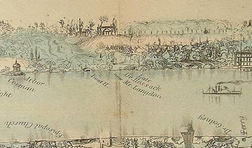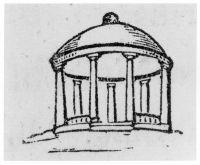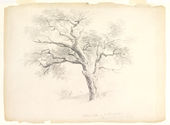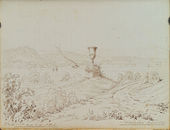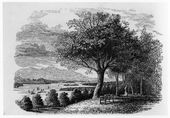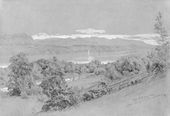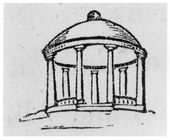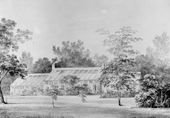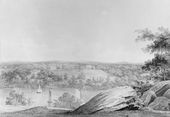Hyde Park (on the Hudson River, NY)
Hyde Park (on the Hudson River, N.Y.)
[Introductory sentence]
Overview
Alternate Names:
Site Dates:
Site Owner:
Site Designer(s):
Hyde Park (on the Hudson River, N.Y.):
[Google maps]
History
--Author
Texts
- Anonymous, July 31, 1829, "A letter from a Tourist to the Editor of the American Farmer" (The American Farmer: 1829: 153), [1]
- "With a view to examine some of the farms and country seats upon the banks of the Hudson, I spent a day at Hyde Park, and was delighted, not only with the charms of nature, but also with the refinements of society, and the spirit of hospitality, prevailing among the inhabitants of this rich and beautiful region. The scenery will sustain a comparison with the finest specimens of English landscape. I passed a bright afternoon in rambling over the grounds, which belonged to the late Doctor Bard, and have recently been purchased by Dr Hosack of New York. They comprise a tract of 700 acres, bounded n the west by "The noble North," and extending back a mile or more into the fertile county of Dutchess. From the beautiful lawn in front of the mansion and the neighboring cottage, the view reaches on one hand to the blue summits of the Catskills, and on the other to the Highlands, in the vicinity of West Point. The Hudson, with its green and rural shores, is visible for the distance of twenty miles. An almost endless variety of venerable forest trees give shade and beauty to the landscape, through which hurries a copious stream, headlong and noisy as the Arno itself, filling the hanging gardens and groves on its borders with murmurs. On the sunny declivity, sloping to this rivulet, I saw ... carts of water-melons, some of them weighing forty pounds each. Fruits and flowers of all kinds are rich and abundant. The woods are vocal with the song of birds, and the squirrel frequently crossed my winding and tangled pathway. In many places, copious and pure fountains gush from the bank of the river, affording a plentiful supply of the best water. The present enterprising proprietor of this farm has but just commenced his system of improvements. With his wealth and taste, he will doubtless render it still more than it is now, a terrestrial paradise.
- "Not far from the splendid grounds of Dr. Hosack, is the residence of Dr Allen, the celebrity of whose classical institution has spread throughout the country and attracted students from distant states. His stately mansion is situated in the midst of a lawn of eighty acres, intersected by avenues and winding walks bordered with ornamental trees. From the window of the library the eye ranges down the banks of the Hudson for a distance of twenty-five or thirty miles, and reposes upon the picturesque scenery on the opposite shore. Here are porches and halls of science, consecrated as the Paecile [river in Italy], and shades deep and classical as the groves of Academus, and waters brighter than Ilissus.... His hours of relaxation from study are frequently employed in walking through the fields with his pupils, conversing familiarly on what they have read, and at the same time enjoying the beauties of nature....
- "The next morning we went to breakfast with one of the doctor's neighbors and friends, the wealthy proprietor of 300 acres, who contented with his success in trade, has had the wisdom to beat his anchors into plough shares, and to retire from the bustle of the city to a rural and romantic retreat at Hyde Park. He has embarked with enthusiasm in agricultural and horticultural pursuits, and his farm, his gardens, and his ornamental grounds are in excellent order, evincing skill and taste in his new profession. The whole atmosphere is charged with the fragrance of flowers, and the perfume of "new-mown hay." In rambling along winding pathways, by the side of gurgling brooks...I here forgot for a time the dejected spirit and morbid feelings of an invalid."
- James Thacher, November 26, 1830, "An excursion on the Hudson. Letter I" (1830: 148-49) [2]
- "Hyde Park, is on the east side, six miles above Poughkeepsie, and divides the distance pretty equally from New York to Albany. This pleasant village received its name from Dr John Bard’s country residence, now in the possession of Dr David Hosack, and this is the extent of my present excursion. Landing at the dock on the premises, we were met by the Doctor’s carriage and conveyed up a circuitous road about half a mile to the mansion. The approach is truly enchanting, the house a palace, the landscape a rural paradise, the respectable occupants distinguished for the kindest hospitality. Hyde Park estate was the country residence of Dr John Bard, and it was the scene of his latter days. After him his son Dr Samuel Bard erected a splendid house and made considerable improvements, while his son in law, Rev. Mr McNickler [sic], erected a beautiful dwelling in the finest style of an English cottage.
- "From both these elegant seats the eye sweeps over the noble Hudson, which is nearly a mile in width, speckled at all times with the white spreading canvas, or the more formidable Fulton steamers. A richer prospect is not to be found, a more varied and fascinating view of picturesque scenery is scarcely to be imagined. The present proprietor, Dr. David Hosack, has since the year 1794, been distinguished for assiduity and devotion to the practical duties of his profession, and fulfilling the office of teacher in various branches of medical science in the city of New York.... Dr Hosack sustained the office of president of the New York Historical Society for several years, and in May, 1824, was elected president of the New York Horticultural Society. He was the founder and proprietor of the Elgin Botanic Garden in 1801, the first and best in the United States, which has been purchased by the Legislature of that State for the purpose of completing a system of medical instruction. Although this eminent physician and philosopher has exchanged his professional labors during the summer months for the delightful scenes of rural and pastoral life, yet he retains a high sense of the importance of medical science, and the public is still to be benefited by his literary labors. He is well qualified as a practical agriculturist and horticulturist, having devoted much attention to the nature of soils and the principles of vegetable life when lecturing on botany and georgics. From the spirit displayed during the short period of 18 months in his system of improvements, it may be predicted that as an agriculturist, he will become no less eminent than in medical erudition."
James Thacher, "An Excursion on the Hudson. Letter II" (1830; 156-57)[3]
- "The mansion house at Hyde Park is elevated about 200 feet above the surface of the river. With its two wings it presents a noble front of 136 feet, and is two stories above the basement. The centre or principal building, has a piazza on both fronts: the west front is open to the Hudson, and the east looks over a spacious, beautiful lawn towards the turnpike from New York to Albany.... The south wing contains a rich and well selected library, consisting of 4 or 5000 vols. Purchased at the expense of $20,000. Here is to be found a collection of works in every branch of literature. In no private library is there a more complete collection of European and American periodical Journals; scarcely a production of merit of this description, but may be found in this collection, and the number id constantly increasing. The Dr has also in his hall and gallery, a valuable collection of paintings, by the first artists both ancient and modern. At a proper distance north from the house, is situated the coach house and stable, built of stone in a chaste style of Grecian simplicity, and is 61 feet in front by 40 deep. At an equal distance south, is to be seen the green house and hot house, a spacious edifice constructed with great architectural taste and elegance, and well calculated for the preservation of the most tender exotics that require protection in our climate. It is composed of a centre and two wings, extending 110 feet in front and front 17 to 20 feet deep. One apartment is appropriated to a large collection of pines. Among the rich display of rare shrubs and plants, are the magnolia grandiflora, the spendid strelitzia, the fragrant farnesiana, and a beautiful tree of the Ficus elastica or Indian rubber, about 8 feet high, 5 years old. Contiguous to the green house is an extensive ornamental garden, in which is arranged in fine style, a beautiful variety of trees, shrubs and flowers; among which stands that glory of the forest, the magnolia glauca, bearing large white flowers, perfuming the atmosphere with a delightful fragerrance. The forest trees which surround the domicile are identically the natives which are found in our forest; some of the oaks are a century in age, and all are large and so grouped and intermingled over the lawnas to present at every step the most fantastic views that can attract the pencil of the artist. From the piazza, and from the bank on the west side of the house we have a charming view, extending to the opposite side of the river, of the blue summits of the Catskill mountains, and many gentlemen’s seats, and cultivated farms. Whether indeed we direct the eye across the river, or glance over its surface north or south, we have a variegated landscape embracing the borders of the noble Hudson, from 20 to 40 miles in extent... From the house, gravelled walks diverge and extend in opposite directions nearly half a mile, exhibiting a diversified scenery of hills and dales, now descending a sloping declivity on the verge of a precipice, again ascending to a commanding plain, opening a scene of unrivalled beauty. At the termination of these romantic walks fanciful pavilions are erected, where visitors may contemplate a captivating display of nature’s magnificence in these regions of wonder. From the turnpike road there are two gates of entrance into the premises, about half a mile from each other, and a porter’s lodge is connected with each gate. The north lodge is 19 by 31 feet, with a portico projecting over the north and south fronts, each supported by 4 Grecian Doric columns. Two wings project from the sides, which serve as lodging rooms. This little building has been much and deservedly admired for its architectural beauty. The entrance gate is finished in a very neat and imposing style of architecture. Mr Thompson of New York, is the skilful architect employed in the construction of these buildings. The south lodge, connected with a neat gateway, with the improvements of the surrounding grounds, present a very picturesque appearance. This is the most commanding point from which to view advantageously the mansion, green house, stable, and out houses, which appear at considerable distance from each other in the extensive lawn. This avenue to the mansion is over a stone bridge, crossing a rapid stream preciptated from the milldams above, and falls in a cascade below. The winding of the road, the varied surface of the ground, the bridge, and the falling of the water, continually vary the prospect and render it a never tiring scene.
- Agriculture.— Hyde Park estate consists of a tract of about 800 acres of excellent land, bordering on the Hudson one mile and half, and extending one mile back from the river; the turnpike from New York to Albany passing through the premises. The farm comprises every variety of soil and aspect, and has not been exhausted by cultivation. It is well wooded and supplied with numerous unceasing springs of pure water. A creek also meanders through the farm, furnishing falls well calculated for manufactories and mill seats, and being dammed at proper places, forms excellent pickerel and trout ponds. The 500 acres under culture yield large crops of hay and grain, and the soil is adapted to the production of every article of luxury and convenience which man can desire. Dr Hosack commences his labors with characteristic ardor, and evinces a fine taste for agricultural pursuits. His improvements are not only in the buildings he has erected, and the establishments of the pleasure grounds, but in the more solid operations of the farm, as levelling hills and precipices, opening roads and avenues, erecting bridges and turning water courses. Many acres of rugged, hilly land hitherto deemed almost inaccessible to the plough or not worth the labor, have this season been subdued, the stones worked into wall and the soil sowed with rye.
- Stock. — …In front of this house, on the lower bank of the river, he has a parkstocked with deer,
- Apiary.— During my visit at Hyde Park, by request of Dr H. I superintended the construction of an apiary upon my improved plan. The house is 30 feet long and two tiers in height and will contain nearly 40 hives, and this affords the greatest facility for taking the honey without destroying the bees. The close house secures the hives from the ravages of the Bee-moth and from the weather, and may be opened occasionally for ventilation…. Dr H. is now in possession of a family of bees without stings which were sent to Dr Mitchell from Mexico. He keeps them in his green house that they may enjoy an atmosphere similar in temperature to that in their native climate. There is on the stream belonging to Dr H. the workshop of Mr Hale, the ingenious inventor of the patent rotary pump…. Dr H. has two of them in operation, at his green house and bathing room.
- Trollope, Frances Milton, 1832, recalling her travels through New York in 1831 (1832: 2: 206), [4]
- "About thirty miles further [from West Point] is Hyde Park, the magnificent seat of Dr. Hosack; here the misty summit of the distant Kaatskill begins to form the outline of the landscape; it is hardly possible to imagine any thing more beautiful than this place. We passed a day there with great enjoyment.
- Hamilton, Thomas, 1833, describing a visit to Hyde Park in December 1830 (1833: 1: 73, 79-82), [5]
- "I determined to give variety to the tisue of my life by accepting the very kind and pressing invitation of Dr Hosack, to visit him at his country-seat on the banks of the Hudson….
- "Though the drive from the landing-place led through a prettily variegated country, I was not much in the humour to admire scenery, and looked, I fear, with more indifference on the improvements past and projected, to which the Doctor directed my attention, than would have been consistent with politeness in a warmer and more comfortable auditor....
- "The following morning... I was glad to accept the invitation of my worthy host, to examine his demesne, which was really very beautiful and extensive. Nothing could be finer than the situation of the house. It stands upon a lofty terrace overhanging the Hudson, whose noble stream lends richness and grandeur to the whole extent of the foreground of the landscape. Above, its waters are seen to approach from a country finely variegated, but unmarked by any peculiar boldness of feature. Below, it is lost among a range of rocky and wooded eminences of highly picturesque outline. In one direction alone, however, is the prospect very extensive; and in that, (the north-west) the Catskill Mountains, sending their bald and rugged summits far up into the sky, form a glorious framework for the picture.
- "We drove through a finely undulating country, in which the glories of the ancient forest have been replaced by bare fields, intersected by hideous zigzag fences. God meant it to be beautiful when he gave such noble varieties of hill and plain, wood and water; but man seemed determined it should be otherwise. No beauty which the axe could remove was suffered to remain....
- "Such changes are not optional, but imperative. The progress of population necessarily involves them, and they must be regarded only as the process by which the wilderness is brought to minister to the wants and enjoyments of civilized man.... It is only the state of transition which is unpleasant to behold; the particular stage of advancement in which the wild grandeur of nature has disappeared, and the charm of cultivation has not yet replaced it."
- Stuart, James, 1833, recalling a his travels through New York (1833: 1: 470) [6]
- "I had been some time engaged in conversation with Dr Hosack, to whom my only introduction was in the steam-boat by Dr. Mitchell of New York, the well-known translator of Cuvier, to whom I had been presented five minutes previously….
- "The drive from Poughkeepsie to Hyde Park and to Rhinebeck passes through a rich undulating country, the ground on the banks of the river commanding as pleasing views as can be imagined. There is a greater number of country seats than I have seen anywhere away from the great towns upon this line of country….
- “Dr. Hosack’s terrace is the finest that I have seen on the river, and possesses views, ending with the Catskill mountains in the distance, that can hardly be surpassed. A great number of workmen are at present employed by him in extensive improvements upon the grounds, and the enlargement of his mansion-house."
- Shirreff, Patrick, 1835, description of a visit to Hyde Park (1835: 29-31) [7]
- "Hyde Park, the seat of Doctor Hosack, is the most celebrated In America, and which Mr Stuart describes as being “embellished as a fine residence and fine grounds in England.” The house is situated some hundreds of feet above the level of, and at a considerable distance from the Hudson, the intervening grounds being finely undulating. In front of the house there is a road, leading from the landing-place on the river, along a small stream, over which there is an elegant wooden bridge, and several artificial cascades have been formed in its channel. The house is composed of wood, as well as the offices and lodges, painted white, and are very neat of their kind. The conservatory had been dismantled a few days before our arrival, by placing the plants in the open air; the collection seemed extensive and well kept. The flower garden is small, the walks limited, and both destitute of beauty. I am aware that most of the evergreens which impart loveliness to the residences in Britain cannot withstand the rigours of an American winter, but this circumstance is no excuse for the nakedness of Hyde Parkwalks, the aid of many native plants having been disregarded. The matchless beauties of the situation have not only been frequently neglected; but destroyed by stiff, formal, naked walks, and the erection of temples resembling meat-safes, without a climbing plant, which the country produces in endless variety, to hide their deformity, and harmonize them with the surrounding scene. In short, while I greatly admired the situation of Hyde Park, I do not recollect having seen a celebrated place where nature had done so much, and man so little, to render beautiful. The embellishments at Hyde Park, contrasted with those met with every day in Britain, place American landscape-gardening immeasurably behind, if it can be said to exist.
- “The progress of a people in refinement and taste, manifested in a combination of nature and art, is commonly the work of time, and the decoration of grounds an unproductive investment of capital. Thus the residences of England having descended for ages in the same line, without the power of possessors changing their destination, may be said to represent the accumulated savings, labours, and tastes of many generations. In America the country has not been long possessed by the present owners, and property does not necessarily descend in the same line; and if to these causes be added the high price of labour, and the scarcity of capital, the state of the residences will be sufficiently accounted for. Dr Hosack has great merit in what he has accomplished, but it is mockery to compare his grounds, in point of embellishments, with the fine places in Britain, which have originated from circumstances which America is not likely soon to experience….
- "Hyde park is also celebrated for its agriculture, which I found under the charge of a gentleman from Fifeshire, Scotland…. The farm offices, which are extensive, would be considered good in most situations, and were the best I saw in America. There was a young hawthorn hedge, well kept, and in a thriving state…."
- Murray, Charles Augustus, 1836, describing his travels through New York (1830: 2: 346-47)[8]
- "I soon came to the lodge of a country-seat, which has been celebrated by almost every British traveller in America, Hyde Park, the residence of the late venerable and hospitable Dr. Hosack. I had never found an opportunity of delivering my letters of introduction to him during my former stay in New York…. Of course his widow received no company, so I resolved to ride through the grounds and see the prospect from them, merely leaving my card, accompanied by an apology for the liberty I had taken.
- "The ground between the road and the house is very bold and undulating, and affords the means of making a pretty small lake, round which the approach winds its course. The house is spacious and comfortable without any pretensions to architectural beauty…. She [the daughter-in-law- of Dr. Hosack] invited me into the house and very kindly offered to show me the "lions:" among the principal of which, indoors, was the library, a most comfortable apartment, containing some tolerable pictures of the Italian and Flemish schools. I soon followed my fair conductress to the other side of the house, where might be seen a picture more glorious than ever mortal pencil designed. Below us flowed the Hudson, studded with white-sailed sloops as far as the eye could reach…; the opposite bank, which slopes gently from the river, is variegated with farms, villages, and woods, appearing as though they had been grouped by the hand of taste rather than that of industry; while on the north-west side the prospect is bounded by the dark and lofty outline of the Catskill range."
- Martineau, Harriet, 1837, recounting her travels through America (1837: 2: 53-54), [9]
- "The prettiest amateur farm I saw was that of the late Dr. Hosack, at Hyde Park, on the Hudson. Dr. Hosack had spared no pains to improve his stock, and his methods of farming, as well as the beauty of his pleasure-grounds.... As for his [[pleasure ground|pleasure-grounds], little was left for the hand of art to do. The natural terrace above the river, green, sweeping, and undulating, is surpassingly beautiful. Dr. Hosack's good taste led him to leave it alone, and to spend his pains on the gardens and conservatory behind. Of all the beautiful country-seats on the Hudson, none can, I think, equal Hyde Park; though many bear a more imposing appearance from the river."
- Downing, Andrew Jackson, 1841, describing the residence of David Hosack (1841: 22, 372-373, 385), [10]
- "Hyde Park, on the Hudson, the seat of the late Dr. Hosack, has been justly celebrated as one of the finest specimens of the modern style of Landscape Gardening in America. Nature has indeed, done much for this place, as the grounds are finely varied, beautifully watered by a lively stream, and the views from the neighbourhood of the house itself, including as they do the noble Hudson, and the superb wooded valley which stretches away until bounded at the horizon by the distant summits of the blue Cattskills, are unrivalled in picturesque beauty. But the efforts of art are not unworthy so rare a locality; and while the native woods, and beautifully undulating grounds are preserved in their original state, the pleasure-grounds, roads, walks, drives, and new plantations, have been laid out in so tasteful a manner as to heighten the charms of nature. Large and costly hot-houses were erected and elegant entrance lodges at two points on the estate, a fine bridge over the stream, and numerous pavilions and seats commanding extensive prospects; in short, nothing was spared to render this [seat]] one of the finest in America. The park, which at one time contained some fine deer, afforded a delightful drive within itself, as the whole estate numbered about seven hundred acres. The plans for laying out the grounds were furnished by Parmentier, and architects from New York were employed in designing and erecting the buildings. Since the death of Dr. Hosack, the place has lost something of the high keeping which it formerly evinced, but we still consider it one of the most instructive seats in this country.....
- "Some noble specimens of the common Three-thorned Acacia, may be seen upon the lawnat Hyde Park, the fine seat of the late Dr. Hosack....
- "There are two methods of grouping shrubs upon lawns which may separately be considered, in combination with "beautiful" and with picturesque scenery.
- "In the first case, where the character of the scene, of the plantations of trees, etc., is that of polished beauty, the belts of shrubs may be arranged similar to herbaceous flowering plants, in arabesque beds, along the walks…. In this case, the shrubs alone, arranged with relation to their height, may occupy the beds, or if preferred, shrubs and flowers may be intermingled. Those who have seen the shrubbery at Hyde Park; the residence of the late Dr. Hosack, which borders the walk leading from the mansion, to the hot-houses, will be able to recall a fine example of this mode of mingling woody and herbacious plants. The belts or borders occupied by the shrubbery and flower-garden there, are perhaps from 25 to 35 feet in width, completely filled with a collection of shrubs and herbaceous plants; the smallest of the latter being quite near the walk; these succeeded by taller species receding from the front of the border, then follow shrubs of moderate size, advancing in height until the background of the whole is a rich mass of tall shrubs and trees of moderate size. The effect of this belt on so large a scale, in high keeping, is remarkably striking and elegant....
- “The temple and the pavilion, are highly finished forms of covered seats, which are occasionally introduced in splendid places, where classic architecture prevails. There is a circular pavilion of this kind at the termination of one of the walks at Dr. Hosack’s residence, Hyde Park. Fig. 57.” [Fig. x]
Images
Inscribed
- Alexander Jackson Davis, "Residence of Dr. Hosack: Lawn Front," c. 1830, black ink and wash over graphite on paper, New-York Historical Society, Gift of Samuel Verplanck Hoffman, 1923.
Thomas Kelah Wharton, "Euterpe Knoll Hyde Park N. York," dated Sept. 11, 1839, pen and ink drawing, Manuscripts and Archives Division, New York Public Library.
Thomas Kelah Wharton, "Crystal Cove, Hyde Park. New York," dated September 11, 1839, pen and ink drawing, Manuscripts and Archives Division, The New York Public Library.
William Wade, Residence of "Late Dr. Hossack [sic] Now Mr. Langdon," engraving, 1847, detail from Panorama of the Hudson River from New York to Waterford (New York: J. Disturnell, 1847).
G.K. Richardson after W.H. Bartlett, "View from Hyde Park (Hudson River)," 1840, Hand-colored steel engraving, from American Scenery; or, Land, lake, and river illustrations of transatlantic nature (London: 1840), vol. 1, no. 23.
Anonymous, "View in the Grounds at Hyde Park," wood engraving, in A. J. Downing, A Treatise on the Theory and Practice of Landscape Gardening (1849), pl. opp. p. 45, fig. 1. National Gallery of Art, Washington, D.C.
Associated
Attributed
Thomas Kelah Wharton, "Bridge over Crumelbow Creek, David Hosack Estate, Hyde Park, New York" (from Hosack Album), ca. 1832, watercolor on off-white wove paper, Metropolitan Museum of Art, Purchase, Mrs. Louis Marx Gift, 1994.
Thomas Kelah Wharton, "View of David Hosack Estate, Hyde Park, New York, with a Sundial" (from Hosack Album), ca. 1832, graphite on white wove Bristol board, 3 x 3 9/16 in. (7.6 x 9 cm), Metropolitan Museum of Art, Purchase, Mrs. Louis Marx Gift, 1994.
Thomas Kelah Wharton, "View of the David Hosack Estate, Hyde Park, New York, from the South" (from Hosack Album), ca. 1832, black ink (or watercolor) applied with pen and brush and sgraffito on off-white wove paper, Metropolitan Museum of Art, Purchase, Mrs. Louis Marx Gift, 1994.
Thomas Kelah Wharton, "View of David Hosack Estate, Hyde Park, New York, from the East" (from Hosack Album), ca. 1832, black ink (or watercolor) applied with pen and brush on off-white wove paper, 5 1/4 x 7 7/16 in. (13.3 x 18.9 cm), Metropolitan Museum of Art, Purchase, Mrs. Louis Marx Gift, 1994.
Thomas Kelah Wharton, "View of the David Hosack Estate at Hyde Park, New York, from Western Bank of the Hudson River" (from Hosack Album), ca. 1832, black ink (or watercolor) applied with pen and brush on off-white wove paper, 5 1/8 x 7 7/16 in. (13 x 18.9 cm), Metropolitan Museum of Art, Purchase, Mrs. Louis Marx Gift, 1994.
Thomas Kelah Wharton, "View of David Hosack Estate, Hyde Park, New York, from the East" (from Hosack Album), ca. 1832, black ink (or watercolor) applied with pen and brush on off-white wove paper, 5 1/4 x 7 7/16 in. (13.3 x 18.9 cm), Metropolitan Museum of Art, Purchase, Mrs. Louis Marx Gift, 1994.187.16
Alexander Jackson Davis, "River Vista, Hyde Park," Franklin D. Roosevelt Library-Museum, Hyde Park, N.Y.
References
Notes
- ↑ Anonymous, "A Letter from a Tourist to the Editor of the American Farmer," The American Farmer, 11 (July 31, 1829), view on Zotero.
- ↑ James Thacher, "An Excursion on the Hudson. Letter I," New England Farmer, 9 (November 26, 1830view on Zotero.
- ↑ James Thacher, "An Excursion on the Hudson. Letter II," New England Farmer, 9 (December 3, 1830), view on Zotero.
- ↑ Frances Milton TrollopeDomestic Manners of the Americans, 2nd ed., 2 vols. (London: Wittaker, Treacher & Co., 1932), view on Zotero.
- ↑ Thomas Hamilton, Men and Manners in America, 2 vols. (Edinburgh and London: William Blackwood and T. Cadell, 1833), view on Zotero.
- ↑ Stuart, James, Three Years in North America, 2 vols. (Edinburgh: Robert Cadell, 1833), view on Zotero.
- ↑ Patrick Shirreff, A Tour through North America; Together with a Comprehensive View of the Canadas and United States (Edinburgh: Oliver and Boyd, 1835), view on Zotero
- ↑ Charles Augustus Murray, Travels in North America during the Years 1834, 1835, & 1836, 2 vols. (London: Richard Bentley, 1839), view on Zotero
- ↑ Harriet Martineau, Society in America, 2 vols. (London: Saunders and Otley, 1837), view on Zotero.
- ↑ Downing, 1841,
